Preparation for Final Show and Button Souvenirs
In this final collaboration, the students worked on finishing up their projects from other sessions that they may not have completed for their art show next week. We also discussed how they could choose what pieces to put in the show and left it up to them entirely, with some encouragement. They made button souvenirs of images they had previously made if they finished their other projects. In addition, they filled out surveys informing us of their opinions of the sessions, which were very positive. Some chose to write an artist statement as well, which we will place next to their work in the exhibition at United Action for Youth here in Iowa City.
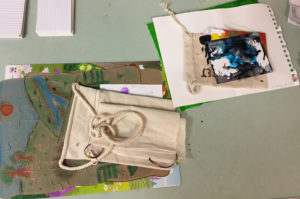
Prepping for the Show: Students’ Choices

Finishing up Some Screen Prints
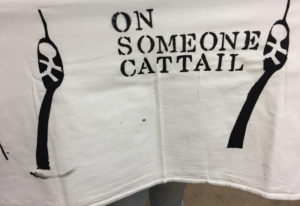
Also Working on a Screen Print from Last Session
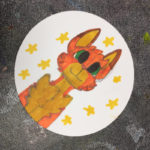
Button in Process
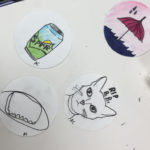
Buttons in Process

Buttons After Being Made
Final Show at UAY in iowa city
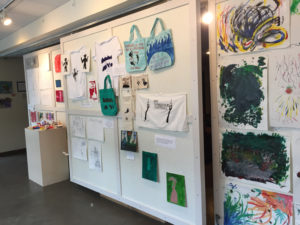
Install view

Max’s comics and our collaborative first lesson
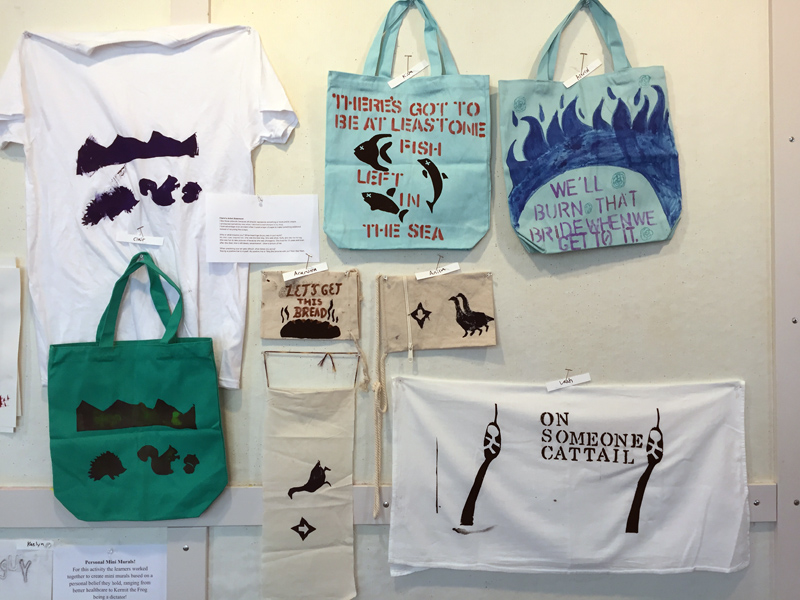
My screen printing view
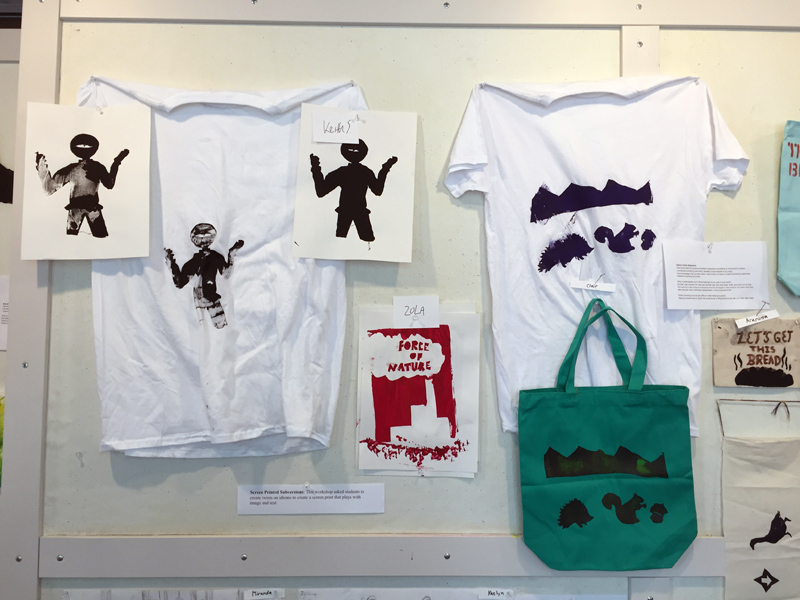
More screen prints

Rub out paintings from the shadow activity

More rub out paintings from the shadow activity
Lesson Plan
Tessa Sutton & Max Johnson
Level or Course: Secondary (grades 7-12)
Time Needed: 90 minutes
Workshop Overview/Goals: In this activity, students will prepare for the final show at the United Action for Youth Center on April 25, by discussing which pieces they will choose for the show and how they want their pieces put together as a group. After finishing up any remaining pieces that they want in the show, they will be composing an artist’s statement for all their work as a whole and filling out a feedback survey for us. We also have a short art activity for them involving making a button or two as a souvenir of the workshops, based on some part of their art that they made during the sessions. Reflection is a key component of Barry Zimmerman’s social cognitive model of self-regulated learning as well as Dewey’s child-centered philosophy.
NAEA Standards:
- Creating: Refine and complete artistic work, Anchor Standard 3.
- Presenting: Select, analyze and interpret artistic work for presentation, Anchor Standard 4.
- Responding: Perceive and analyze artistic work, Anchor Standard 7.
- Connecting: Synthesize and relate knowledge and personal experiences to make art, Anchor Standard 10.
Objectives:
- TLW finish and select works that they want to present for their art show, as well as look over and critique both their work and the work of their peers in order to make the best choices for the show, Anchor Standard 4, Standard 7 & Standard 3.
- TLW create a button based from their favorite art activity from previous workshops. This will show that the learners will understand how to create a work of art in the form of the button and think about their most memorable work, Anchor Standard 3 & Standard 10.
- TLW create an artist statement in order to articulate what art means to them, how they plan on using art in the future, and reflect on their own personal style and works through the self-assessment worksheets, Anchor Standard 10.
Visuals:
Marcel Duchamp, Boîte-en-valise, 1935-41. Leather valise containing miniature replicas, photographs and color reproductions of works by Duchamp, overall dimensions: 16 x 15 x 4 in.
Teacher Example:
Tessa:
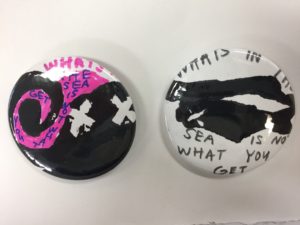
Button Example: What’s in the Sea is Not What You Get.
Vocabulary:
Line: Line is a mark with greater length than width. Lines can be horizontal, vertical,
or diagonal; straight or curved; thick or thin.
Color: is light reflected off of objects. Color has three main characteristics: hue
(the name of the color, such as red, green, blue, etc.), value (how light or dark it
is), and intensity (how bright or dull it is).
Emphasis: force or intensity of expression that gives impressiveness or importance to something.
Souvenir: something that serves as a reminder.
Artist statement: a written text accompanying visual art that gives adds another dimension of meaning and understanding to artistic process.
Supplies, Materials and Resources Needed:
Supplies: Button maker, computer, monitor, any necessary cables.
Materials: Previous student artwork to complete, button backs and fronts, plastic covers, paper in circles for buttons, markers, pencils, erasers, alcohol inks, droppers, rubbing alcohol, oil paint, acrylic paint, brushes, water cups, paper plates, screen printing ink, spoons, paper, T-shirts, bags, paper.
Technology: Computer, monitor, HDMI or other cables to attach computer to monitor
TEACHING PROCEDURE PLAn
Launch: (3 min.)
1. Overview of the final workshop and explanation that they will be finishing up any old work that they want to complete for the show, writing an artist statement, survey and prompts as a summative assessment as well as making a souvenir button.
Instruction or Demonstration with Problem: (5 min.)
2. Discussion about what artwork to choose to put in the show and how we should display their work either by person or by activity.
3. Show the button activity and pass out button circle paper. Teacher will handle the button making machine.
Create: (70 min.)
4. Students work on any pieces that they want to finish up and place in the show and make their button about a part of their art they made already or some aspect of the workshops.
5. Students will write an artist statement. Sheet is attached below.
Closure: (12 min.)
6. Students will fill out a summative self-assessment with prompts (see below in this document) and the workshop survey in order to provide feedback to us about the activities.
Rubric/Assessments/Evaluation/Feedback:
Formative:
- Questions:
- What were some aspects of our workshop activities that you found engaging?
- What were some parts that were not engaging? If any, what?
- Where there any workshop activities that challenged you? How so?
- Where there any projects you wish you could go back and re-make?
- What works are you planning on using for your buttons?
- Observations:
- How the learners are engaging in the discussion, what answers are they giving for the questions, if any.
- Observe what works of art the learners are using for their buttons.
- See if they are taking the concept of creating an artist statement seriously.
Summative:
Students will be given a self-assessment with prompts to fill out about their work and progress in the workshops. They will also be asked to write a survey over their thoughts about their activities and what can be improved
Accommodations, Enrichments & Extensions
Students who may have difficulty with this lesson:
Accommodations can be made for students who have trouble holding or grasping materials by creating a sponge for them to put their brush or pencil inside of. Students who are hard of hearing may sit nearer to the instructors as well as sight impaired students. Presentations will have large font for people at the back to see clearly.
Advanced Learners: These students can discuss with the teacher about their ideas on how to hang the show or do research on group art shows on their phone.
Students who finish early: These students can make extra buttons or double check they have completed the work for the show.
References:
Duchamp, M. (1935-1941). Retrieved from https://www.moma.org/interactives/exhibitions/1999/muse/artist_pages/duchamp_boite.html.
*Survey and Artist Statement are on the following pages.
Final Workshop Survey
Before you all leave us to pursue bigger and better things, we wanted to ask you a few questions about the time you spent here with us over the past few weeks. These are anonymous and you only need to answer what you want to answer, so feel free to tell us what you’re thinking! Feel free to draw the answers if you want as well!
- What would you say was the most enjoyable part about coming to workshops?
- Out of all the workshop activities which one had the biggest impact on your art?
- If you could go back in time and change one thing about the activities you did, what would it be?
- Did any of these activities offer challenges in art you haven’t faced before? Which ones if any?
- What are some comments you want to give Max and Tessa?
________________________________________________________________________
Artist Statement by _______________________________________________
I like these artworks because _____________________________________________________________________________
I envisioned something new when I decided to add ________________________________________________________________
to my artwork.
I took advantage of an accident when I ____________________________________________________________________________
Describe why you chose to do the art you make. Who or what inspired you? What meanings do you see in your work?
When practicing your art gets difficult, what keeps you going?
Example of a Student’s Response:
An Artist Statement
I like these artworks because they show improvement as an artist.
I envisioned something new when I decided to add different mediums.
I took advantage of an accident when I accidentally made my clover look like a dandelion.
Who or what inspires you? What meanings do you see in your work?
My dreams inspired me, so it can be hard to tell meaning from it.
When practicing your art gets difficult, what keeps you going?
Going back to paper and pencil and doodling something small.
___________________________________________________________
Survey for Team Tessa!
Please rate the workshops on a scale of 1-5 & circle answer for each one:
5 = Extremely engaging & challenging
4= Very engaging & challenging
3= Somewhat engaging & challenging
2=Not very engaging or challenging
1=I didn’t like this very much.
Workshop #3 – Puzzling Over Memory
5 4 3 2 1
Comments/Why did you choose your number?
Workshop #5 – Playing with Identity in Shadows & Painting
5 4 3 2 1
Comments/Why did you choose your number?
Workshop #7 – Subverting Screen Printed Idioms
5 4 3 2 1
Comments/Why did you choose your number?
Additional comments for Tessa: How can I improve teaching kids at your age and higher ability levels? Other suggestions? I learned a lot from working with you folks, so thank you.